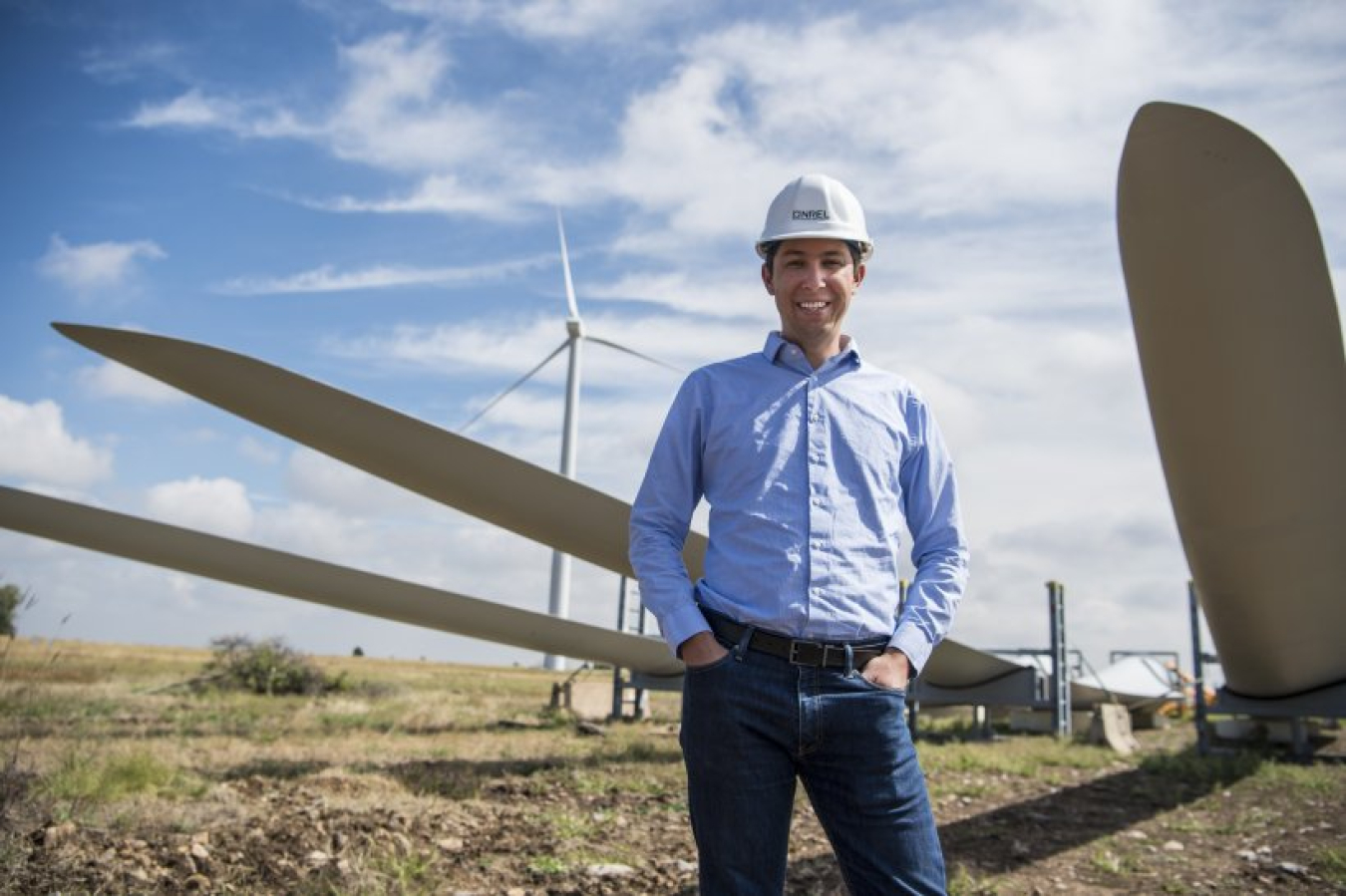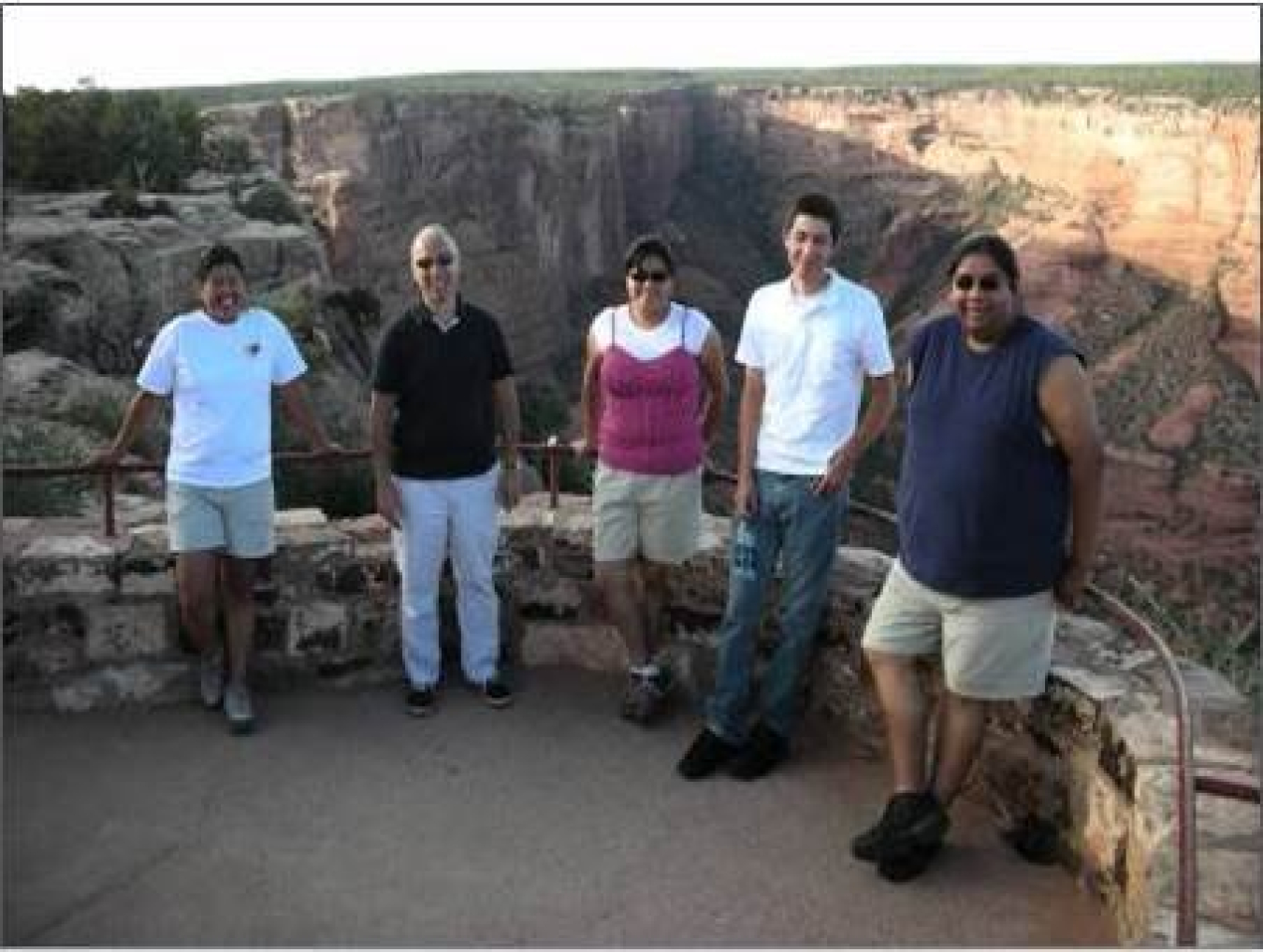Name: Nick Johnson; Institution: University of Colorado; Program: DOE Office of Indian Energy’s summer internship program & Science Undergraduate Laboratory Internships (SULI); Education Level: Undergraduate Student
October 23, 2018Standing in front of one of the largest wind turbines in view, Nick Johnson reflected on the industry’s growth since his first walk down this wind-blown and dusty road more than 10 years ago.
The road runs adjacent to the massive white turbines spinning at the National Wind Technology Center (NWTC) in Boulder, Colorado—a second campus of the U.S. Department of Energy’s (DOE) National Renewable Energy Laboratory (NREL)—where Johnson is a mechanical engineer and principal investigator (PI).

Nick Johnson came to NREL as an intern, continued on to a tribal energy internship sponsored by DOE at Sandia National Labs, worked for the DOE Wind Energy Technologies Office, and is now an engineer working at the National Wind Technology Center
He has come a long way since his first encounter with renewable energy research back in 2006—and much like wind technology, he has DOE to thank for a considerable portion of his growth. Through more than a decade of maturation from wide-eyed fledgling intern to PI at a DOE national lab, Johnson spent time working in industry and directly for DOE, but he started by rotating through NREL and Sandia National Laboratories with two separate internships.
The most recent—2007—was the summer he spent at Sandia as a tribal energy intern in what is now the DOE Office of Indian Energy’s summer internship program. There, he explored the energy successes and challenges often faced by American Indian tribes and Alaska Native villages. Much like other interns who’ve gone through the program, he was impacted by the program’s site visits to tribal lands—and the impact of energy technologies on the tribes he visited.

Nick Johnson (second from right) with the rest of the 2007 class of tribal energy interns at Navajo Nation's Canyon de Chelly in Arizona, along with Thomas Sacco, the Program Manager at the time.
“Some sites were completely off the grid,” he said. “These people had been living generations without access to electricity. This was stepping forward in time hundreds of years for them. We went to a home that never had a refrigerator before. Energy technology allowed them to live the way they wanted to live with some modern conveniences.”
Johnson’s mother is Native American and a member of the Three Affiliated Tribes—Mandan, Hidatsa, and Arikara—located in North Dakota. Johnson is affiliated with the Arikara and Hidatsa tribes. He spent his childhood in Colorado, looking forward to his family’s annual summer trips to North Dakota to visit relatives and enjoy his Tribes’ gatherings.
“Respecting people and earth were the takeaways from those experiences as a kid,” Johnson said. “Some of those values and traditions of treating the Earth with respect left an indelible mark on me. It’s what led me to wanting to have an impact in those areas, and specifically a career in renewable energy.”
Johnson said he’s always wanted to have a positive impact on the world. His education—coupled with values he’s carried from childhood that are intrinsic to his culture—helped carry him to renewable energy, but the road was anything but straight. He said that after high school, he didn’t know what he wanted to do. He took several college courses, considering teaching high school one minute and working in sociology the next. In the end, something clicked when he started learning physics and taking more math classes.
By 2006, he had developed an interest in renewable energy. When he found NREL’s Science Undergraduate Laboratory Internship (SULI) program, he applied and enrolled. Since then, he’s spent most of his career working with renewable energy in some form or another—but says NREL left its mark early.
“Ever since my internship in ’06, I knew this was where I wanted to work,” Johnson said. “All these little things I’d been doing—planting these little seeds along the way—getting my master’s degree, working at DOE and gaining some experience in industry—were seeds to try and get back here. This is where I’ve always wanted to be.”
The ability to walk in a researcher’s shoes for a little while helped, he said, adding that his experience during the SULI internship “demystified the process and the technology.”
Later, after the Sandia internship and stints working for industry and the DOE Wind Energy Technologies Office, Johnson would visit NREL again—this time for a year, while working on his master’s in mechanical engineering at the Colorado School of Mines in 2014. He became part of the NREL team full time in 2018.
“On my own personal journey—how much I’ve grown over 12-plus years and all the experiences I’ve gained—it’s nice to come back and look around through the halls and see the young faces and the next generation of engineers,” he said. “Not too long ago, I was one of them.”
He also reflected on how much the NWTC campus has changed in that time.
“When I was here in ‘06, the biggest turbines here were 300 kilowatts,” he said. “I thought those were amazing and great and big. Now there are multi-megawatt turbines on site. It’s a testament to how much the industry has grown.”
[The internship] really aligned with everything I valued. In American Indian culture, relationships and trust are huge. There is a technical side of what I do, but there is also a facilitating side that I think is equally important. Maintaining relationships and being open—engendering trust on both sides—and treating people on the project fairly.
As an intern at Sandia back in 2007, Johnson authored a research paper on small wind turbines on tribal lands. Since then, his work has continued to focus on wind technologies, with a focus on “aeroelastic” software—which was originally developed at NREL. The aero part alludes to aerodynamics, and the elastic part considers the materials themselves. He and his fellow PIs are constantly applying research to improve essential components of wind turbines.
Along with his expertise in mechanical engineering, Johnson relies on interpersonal communication and project management skills every day. He recalled that it was through networking that he became aware of the Sandia internship opportunity—and that the networking skills he polished during the internship help to keep his projects on track today.
“[The internship] really aligned with everything I valued,” he said. “In American Indian culture, relationships and trust are huge. There is a technical side of what I do, but there is also a facilitating side that I think is equally important. Maintaining relationships and being open—engendering trust on both sides—and treating people on the project fairly.”
To any qualified candidate considering applying to either the NREL SULI or DOE Indian Energy internship programs, Johnson advises: “Follow your heart and make sure it’s aligned with what you really want to do. Make sure it’s something you’re really interested in and go into it with an open mind.”
Learn more about the Office of Indian Energy college student summer internship program at Sandia and the SULI internship program at NREL.

